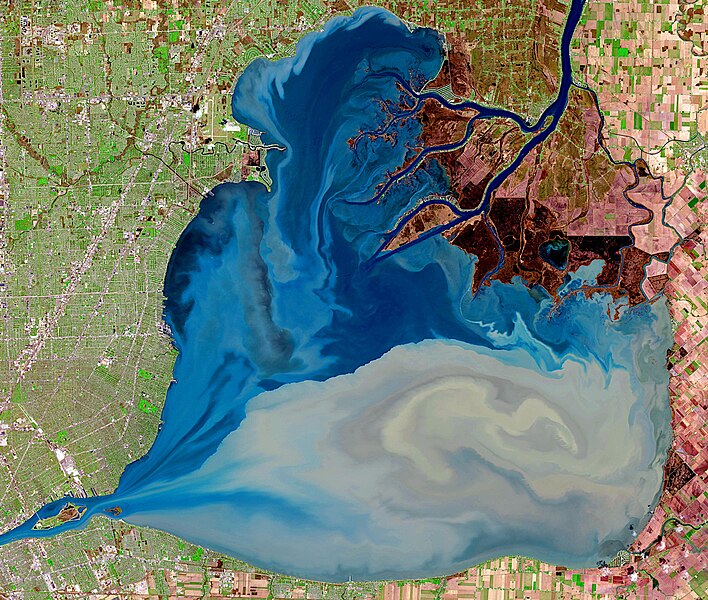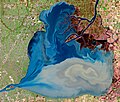English: This image, acquired on 19 April 2023 by one of the Copernicus Sentinel-2 satellites, depicts Lake Saint Clair. While not one of the five Great Lakes of North America, it is a part of the Great Lakes system.
During the winter months, the lake's climate is shaped by cold air masses from the Arctic Circle, resulting in the formation of sea ice in the lake's waters and heavy snowfall in surrounding areas. As spring arrives and the thawing process begins, Lake Saint Clair transforms. The increased water turbidity resulting from the snow and ice melting leads to the formation of stunning patterns, with swirls of blue and purple blending together in a hypnotic display.
Deutsch: Lake St. Clair, aufgenommen am 19. April 2023 von einem der Copernicus Sentinel-2-Satelliten.
Obwohl er nicht zu den fünf Großen Seen Nordamerikas gehört, ist er Teil des Systems der Großen Seen.
In den Wintermonaten wird das Klima des Sees durch kalte Luftmassen vom Polarkreis geprägt, was zur Bildung von Meereis in den Gewässern des Sees und zu starken Schneefällen in den umliegenden Gebieten führt. Mit dem Eintreffen des Frühlings und dem Beginn des Tauwetters verändert sich der Lake Saint Clair. Durch die erhöhte Wassertrübung infolge der Schnee- und Eisschmelze bilden sich atemberaubende Muster, bei denen sich blaue und violette Strudel zu einem hypnotischen Schauspiel vermischen.
Français : Lac Sainte-Claire, séparant le Michigan (USA) de l' Ontario (CA). Image acquise par l'un des satellites Sentinel-2 le 19 avril 2023. Les différentes structures de couleurs résultent des mouvements engendrés par la fonte des glaces et de la neige.
Українська: Танення снігу та льоду на озері Сент-Клер, створює приголомшливі кольорові візерунки. Кордон Онтаріо, Канада, і Мічиган, США.
Italiano: Questa immagine, acquisita il 19 aprile 2023 da uno dei satelliti Copernicus Sentinel-2, raffigura il lago St. Clair, uno dei Grandi Laghi del Nord America. Durante i mesi invernali, il clima del lago è modellato dalle masse di aria fredda provenienti dal Circolo polare artico, con la conseguente formazione di ghiaccio di acqua di mare nelle acque del lago e le abbondanti nevicate nelle aree circostanti. Con l'arrivo della primavera e l'inizio del disgelo, il lago St. clair si trasforma. A causa dello scioglimento della neve e del ghiaccio, la torbidità dell'acqua aumenta fino a formare una straordinaria colorazione con vortici di colore blu e viola che si fondono insieme creando uno spettacolo ipnotico.
Polski: To zdjęcie, zrobione 19 kwietnia 2023 przez jednego z satelitów Copernicus Sentinel-2, przedstawia Jezioro St. Clair, które leży pośród Wielkich jezior, chociaż samo nie jest jednym z nich. Podczas miesięcy zimowych klimat jeziora jest kształtowany przez masy zimnego powietrza arktycznego, przez które w wodach jeziora powstaje lód z wody morskiej, a w okolicy występują intensywne opady śniegu. Wraz z nadejściem wiosny i roztopów jezioro ulega transformacji. Zwiększona mętność wody, wynikająca z topnienia lodu i śniegu, prowadzi do formowania się niezwykłych wzorów, w których mieszają się ze sobą hipnotyzujące spirale barw niebieskich i fioletów.
Português: Esta imagem, obtida em 19 de abril de 2023 por um dos satélites Copernicus Sentinel-2, retrata o Lago Saint Clair. Embora não seja um dos cinco Grandes Lagos da América do Norte, faz parte do sistema dos Grandes Lagos. Durante os meses de inverno, o clima do lago é moldado por massas de ar frio vindas do Círculo Polar Ártico, o que resulta na formação de gelo marinho nas águas do lago e numa forte queda de neve nas áreas circundantes. Com a chegada da primavera e o início do processo de degelo, o Lago Saint Clair transforma-se. O aumento da turbidez da água resultante da neve e do derretimento do gelo leva à formação de padrões deslumbrantes, com redemoinhos de azul e roxo que se misturam num espetáculo hipnótico.
Español: Esta imagen, adquirida el 19 de abril de 2023 por uno de los satélites Sentinel-2 de Copernicus, muestra el lago Saint Clair.
Aunque no es uno de los cinco Grandes Lagos de Norteamérica, forma parte del sistema de los Grandes Lagos. sistema de los Grandes Lagos.
Durante los meses de invierno, el clima del lago está determinado por las masas de aire frío procedentes del Círculo Polar Ártico. del Círculo Polar Ártico, lo que provoca la formación de hielo marino en las aguas del lago y fuertes nevadas. en las aguas del lago y fuertes nevadas en las zonas circundantes. Al llegar la primavera Cuando llega la primavera y comienza el proceso de descongelación, el lago Saint Clair se transforma. El El aumento de la turbidez del agua debido a la fusión de la nieve y el hielo a la formación de patrones impresionantes, con remolinos de azul y púrpura que se mezclan en un espectáculo hipnótico. |







